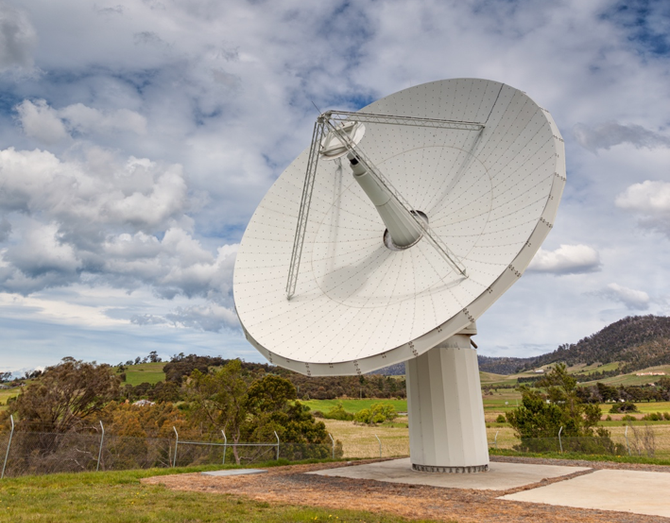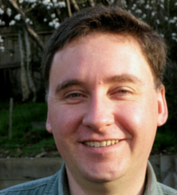University of Tasmania scientists have successfully completed tests on a revolutionary new instrument that will make it possible to measure the Earth and the effects of climate change with millimetre precision and also map our Galaxy.
Measuring positions on the Earth is difficult because everything is moving and there’s no fixed reference point.
To measure where we are, we need to compare to things far away from the Earth that don't move. Those things are called quasars and are located at the edge of the Universe. Quasars are powered by black holes and appear only as a very small point when observed from Earth.
New technologies need to be developed to achieve this and a critical component is the instrument at the focus of the radio telescopes that receives light from distant quasars.
A prototype receiver, provided by Callisto, that is much broader bandwidth than existing systems has been under testing at our Mount Pleasant Observatory near Hobart for the past few months. This testing has just culminated in observations with a similar telescope at Ishioka in Japan. Both telescopes observed a quasar called 3C279 in the constellation of Virgo. The light received by the telescopes left the quasar nearly five billion years ago.
Dr Jim Lovell is an astronomer at the University of Tasmania’s School of Physical Sciences.
"We were able to combine the signals from the telescopes and measure the difference in arrival time to an accuracy needed to locate them to 1 millimeter. It’s really exciting because it tells us that the instrument is working," he said.

Australia’s contribution to the network includes three radio telescopes across the continent, Yarragadee (WA), Katherine (NT) and Hobart (TAS).
"Quasars are so far away that the signal that comes from them takes billions of years to get to us even though it's travelling at 300,000 km a second. They are powered by black holes and appear as very small points of light when observed from Earth. That’s why they form an ideal frame of reference.
"If you have two radio telescopes you can measure how long it takes for the quasar signal to reach one telescope compared to the other. This difference in time tells you how far apart the telescopes are. At the moment, these measurements can be made to centimetre precision.
A frame of reference accurate on millimetre scales is needed to study important geophysical and climate processes, such as the effects of the melting of glaciers on sea level rise.
This is the first time that this new technology has been used to measure distances across the Pacific and also the first time a telescope in the southern hemisphere has been used. Global coverage is essential for this technique to be successful, so contributions from Australia to a worldwide network of observatories are critically important.
The network is operated by UTAS as part of AuScope, which provides infrastructure for research in geological, geochemical, geophysical, and geospatial subjects. UTAS is the only university in the world to operate a continent-wide array of radio telescopes.
The new receivers, which will be installed at the three AuScope telescopes early next year, will also allow astronomers to map our galaxy. Professor Simon Ellingsen at the UTAS School of Physical Sciences is leading a team that will take advantage of these new developments to look through the gas and dust between the stars in our galaxy to map the spiral arms.
:It’s very difficult to work out the shape and structure of our galaxy because the Earth is inside it. In effect it’s hard to see the wood for the trees and we actually know more about how other galaxies look than our own at the moment," he said.
There are parts of the galaxy that are only visible from the southern hemisphere and we need an array of telescopes that are thousands of kilometres apart in order to measure distances to the young stars that live in the spiral arms.
The receiver upgrade has been made possible as a result of Australian Research Council Linkage Infrastructure, Equipment and Facilities (LIEF) funding. The project is a partnership between UTAS, Harvard-Smithsonian Centre for Astrophysics (USA), Geoscience Australia, CSIRO Astronomy and Space Science, Auckland University of Technology (NZ), Max Planck Institute for Radio Astronomy (Germany) and Callisto (France).
AuScope is funded by the Australian Government under the National Collaborative Research Infrastructure Strategy (NCRIS). It involves a collaboration between universities, territory, state and federal governments and Geoscience Australia. For more information, visit: http://www.auscope.org.au/
The new receiver is manufactured by Callisto (Toulouse, France) who provide sensitive instrumentation for radio telescopes. At the heart of this new receiver is an innovative wideband antenna feed, specifically designed for radio astronomy applications by the California Institute of Technology. For more information visit: www.callisto-space.com
Interested in conducting your own research? Apply now to become a research student.
